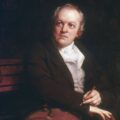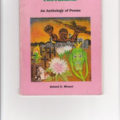Written Near a Port on a Dark Evening
Huge vapours brood above the clifted shore,
Night on the ocean settles dark and mute,
Save where is heard the repercussive roar
Of drowsy billows on the rugged foot
Of rocks remote; or still more distant tone
Of seamen in the anchored bark that tell
The watch relieved; or one deep voice alone
Singing the hour, and bidding “Strike the bell!”
All is black shadow but the lucid line
Marked by the light surf on the level sand,
Or where afar the ship-lights faintly shine
Like wandering fairy fires, that oft on land
Misled the pilgrim–such the dubious ray
That wavering reason lends in life’s long darkling way.
Written Near a Port on a Dark Evening Summary
Big, moody clouds hang above the cliffs along the shore. Night falls over the ocean, and everything is dark and silent except for the rhythmic crash of lazy waves against the uneven base of faraway rocks; except for the even more distant sound of sailors in an anchored boat as they tell the watch shift to go to sleep; except for the sound of a single deep voice yelling out the time and declaring that the ship’s bell should be struck. Everything is as dark as a shadow except for the clear line created by the white foam of waves breaking on the flat shoreline, except for the lights of far-off boats that shine like moving fairy fires, which often mislead travelers wandering on land—in the same way, human reason casts an untrustworthy light that people try to use while navigating life’s long, dark path.
Themes
As the poem’s speaker describes an ocean at night, this vast and disorienting setting comes to metaphorically represent life’s many uncertainties. The imposing, foreboding natural landscape makes the speaker feel intensely isolated and lost, and through this the poem suggests the limits of human beings’ capacity to make sense of the world around them.
Trying to navigate one’s way through the world, the speaker suggests, is like facing a wide, dark ocean. In this ocean there are a few “remote” sounds and distant ship lights, but they don’t successfully guide people through the unknown. In the same way, the speaker argues, it might seem like it’s possible to use reason to better understand the world, but such thinking only gives people false confidence as they wander blindly through “life’s long darkling way.”
One way that the poem explores the relationship between uncertainty and human reason is by acknowledging that trivial things can sometimes feel comforting and familiar. Looking out at the dark ocean is disorienting, which is why things like the sound of sailors’ voices or waves against rocks seem reassuring—after all, these sounds are familiar, making it easier for people to fight off feelings of confusion. Yet these rocks are “remote” and unseen, as are the sailors’ voices. This, in turn, ends up creating a sense of discombobulation in the poem, indicating that things that appear familiar aren’t necessarily as reassuring or grounding as one might assume.
The lights of passing ships on the horizon are similar in that they don’t actually help people make sense of the dark ocean. For this reason, the speaker compares the ship lights to “wandering fairy fires,” saying that they mislead travelers. “Fairy fires” are pieces of decaying wood that glow in the dark, deceiving wayward travelers who mistake them for signs of shelter or human activity.
Although it’s natural to assume that light would give clarity to people moving through darkness, it becomes clear in this simile that this isn’t always the case. In fact, the speaker implies that such lights can create an unwarranted feeling of certainty in people who would be better off accepting that they’re completely lost.
Very few things, then, can truly make “life’s long darkling way” feel less unknowable or baffling. Like peering out at the ocean at night, the experience of being alive is inevitably full of uncertainty, and no amount of human reason—which the speaker casts as unreliable and “wavering”—will change this.
Line Analysis
Line 1-2
The speaker begins the poem by setting a dark, ominous scene. “Huge” clouds “brood” above a seashore lined by cliffs. This personification (and more specifically pathetic fallacy) presents the clouds themselves as moody and ominous (to “brood” means to worry or mope). Clouds can’t literally brood, of course, and this description seems to reflect the speaker’s own state of mind, projected onto the surrounding environment. The poem opens on a foreboding note, vividly conveying the intimidating feeling of staring out at an ocean on a stormy evening.
The second line digs into this feeling, as the speaker describes the night as “dark and mute.” The word “mute” suggests that the entire setting is strangely quiet, as if the poem takes place very far away from the standard noises of daily life. Such descriptions draw upon imagery that makes it easier for readers to envision this “dark,” silent place.
“Written Near a Port on a Dark Evening” is written in iambic pentameter, meaning that its lines are mostly made up of five iambs (metrical feet consisting of an unstressed syllable followed by a stressed syllable, da-DUM):
Huge va– | pours brood | above | the clif– | ted shore,
Night on | the o– | cean set– | tles dark | and mute
The steady iambic rhythm reflects the rolling clouds and the subtle sound of waves. That said, the meter isn’t perfect. The second line starts with a trochee (a foot with a stressed syllable followed by an unstressed syllable) and the first foot of line 1 can also be read as being a spondee (meaning that both syllables are stressed: “Huge va-“).
These are minor variations, but they still manage to make the language sound just a little less predictable and, because of this, ever so slightly unsettling.
Rhyme scheme
The poem’s rhyme scheme follows the conventions of a Shakespearean sonnet. It can be mapped out like this:
ABAB CDCD EFEF GG
Nearly every rhyme in the poem is a perfect end rhyme, creating a musical and confident sound. However, the first quatrain features the poem’s only slant rhyme, rhyming “mute” with “foot.” This makes the beginning of the poem sound somewhat off-kilter and keeps the poem from sounding too tidy or perfect. This, in turn, leads to a vaguely unsettled sound that aligns with the disconcerting feeling of looking out at a vast ocean at night.
At the same time, everything else about the rhyme scheme is very straightforward. The poem culminates in a very obvious rhyme between the words “ray” and “way” in the final couplet, thereby ending on cohesive, conclusive note. As such, the poem has a very satisfying and musical sound that draws readers through the lines, creating a feeling of predictability and consistency that the subject matter otherwise lacks.
Lannamann, Taylor. "Written Near a Port on a Dark Evening." LitCharts. LitCharts LLC, 17 Sep 2020. Web. 3 Feb 2021.By: T.Titus Nyakudyara
Twitter: @NyakudyaraTitus





Latest Comments